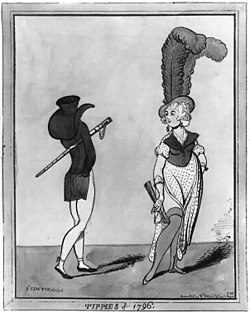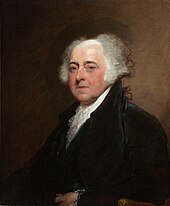Exaggeration

Exaggeration is the representation of something as more extreme or dramatic than it is, intentionally or unintentionally. It can be a rhetorical device or figure of speech, used to evoke strong feelings or to create a strong impression.
Amplifying achievements, obstacles and problems to seek attention is an everyday occurrence[1] Inflating the difficulty of achieving a goal after attaining it, can be used to bolster self-esteem.[2]
In the arts, exaggerations are used to create emphasis or effect. As a literary device, exaggerations are often used in poetry, and is frequently encountered in casual speech.[3] Many times the usages of hyperbole describes something as better or worse than it really is. [4] An example of hyperbole is: "The bag weighed a ton."[5] Hyperbole makes the point that the bag was very heavy, though it probably does not weigh a ton.[6]
Exaggerating is also a type of deception,[7] as well as a means of malingering – magnifying small injuries or discomforts as an excuse to avoid responsibilities.[8]
Etymology[edit]
The word has origins in the mid-16th century: from Latin exaggerat- 'heaped up', from the verb exaggerare, from ex- 'thoroughly' + aggerare 'heap up' (from agger 'heap'). The word originally meant 'pile up, accumulate', later 'intensify praise or blame', giving rise to current senses.
In the arts[edit]
The exaggerator has been a familiar figure in Western culture since at least Aristotle's discussion of the alazon.[9]
Expressionism[edit]
Harold Bloom describes expressionist art as attempting to "intensify the expression of feeling and attitude by exaggeration".[10] Harold Osborne writes that in its wake, even the "new and hard realism...kept much of the distortion and exaggeration which had been one of the chief devices of earlier Expressionism".[11]
Tragedy[edit]

Although primarily a comic figure, the boastful alazon may be one aspect of the tragic hero as well: the touch of miles gloriosus ("braggart soldier") in Tamburlaine, even in Othello, has been commented upon, as has the touch of the obsessed philosopher in Faustus and Hamlet'.[12]
Humour[edit]
Emil Draitser writes that "Some theoreticians of the comic consider exaggeration to be a universal comic device."[13] It may take different forms in different genres, but in the words of M. Eastman and W. Fry, all rely on the fact that 'the easiest way to make things laughable is to exaggerate to the point of absurdity their salient traits'.[14]
A caricature is a type of portrait that exaggerates or distorts the essence of a person or thing to create an easily identifiable visual likeness: Filippo Baldinucci describes this as "disproportionately increasing and emphasizing the defects of the features".[15] In literature, a caricature is a description of a person using exaggeration of some characteristics and oversimplification of others.[16]
Slapstick is the recourse to humor involving exaggerated physical activity which exceeds the boundaries of common sense.[17][18][19] These exaggerated depictions are often found in cartoons, and light film comedies aimed at younger audiences.
Overacting[edit]
Overacting is the exaggeration of gestures and speech when acting. It may be unintentional, particularly in the case of a bad actor, or be required for the role. For the latter, it is commonly used in comical situations or to stress the evil characteristics of a villain. Since the perception of acting quality differs between people the extent of overacting can be subjective.
Exaggeration is an effect especially useful for animation, as perfect imitation of reality can look static and dull in cartoons.[20] The level of exaggeration depends on whether one seeks realism or a particular style, like a caricature or the style of a specific artist. The classical definition of exaggeration, employed by Disney, was to remain true to reality, just presenting it in a wilder, more extreme form.[21] Other forms of exaggeration can involve the supernatural or surreal, alterations in the physical features of a character; or elements in the storyline itself.[22] It is important to employ a certain level of restraint when using exaggeration. If a scene contains several elements, there should be a balance in how those elements are exaggerated in relation to each other, to avoid confusing or overawing the viewer.[23]
Shock jockery[edit]
A shock jock, a type of radio broadcaster or disc jockey, entertains listeners or attracts attention using humor or melodramatic exaggeration that some portion of the listening audience may find offensive.
In journalism[edit]
Schopenhauer saw exaggeration as essential to journalism.[24] He may have overstated this case, but yellow journalism thrived on exaggeration,[25] and fact-checking and independent verification have not succeeded in suppressing clickbait or hyperbolic headlines.
In politics[edit]

Politicians can exaggerate.[27] In the electoral process one may expect exaggeration.[28] Outside, the exaggerations of propaganda[29] can bolster an incumbent's position.
In psychology[edit]
People with the following mental health issues are prone to make exaggerated representations:
- Factitious disorder/malingering,[30]
- Substance related and addictive disorders
- Acute stress disorder,[30]
- Post traumatic stress disorder,[30]
- Avoidant personality disorder,[30] and
- Narcissistic personality disorder.[30]
Factitious disorder is when a person acts as if they have a physical or psychological illness. People with this disorder created the symptoms and are willing to undergo painful or risky tests to get sympathy and special attention.[31]
In popular culture[edit]
In 1969, The Monty Python Dirty Fork sketch demonstrates an absurd level of catastrophization where restaurant staff commit suicide and murder each other because of a customer complaint of a dirty fork. Compare with the scene in the film Monty Python and the Holy Grail[32] involving the Black Knight character which is the opposite extreme of absurdity (minimisation).[33][32]
See also[edit]
References[edit]
- ^ Daniel Goleman, Emotional Intelligence (London 1996) p. 113.
- ^ Beth Azar "All puffed up" Monitor on Psychology, June 2007, Vol 38, No. 6.
- ^ "Definition of Hyperbole". Retrieved 10 January 2014.
- ^ "Definition of HYPERBOLE". www.merriam-webster.com.
- ^ Mahony, David (2003). Literacy Tests Year 7. Pascal Press. p. 82. ISBN 978-1877085369.
- ^ "Hyperbole". Byu.edu. Retrieved 10 January 2014.
- ^ Guerrero, L., Anderson, P., Afifi, W. (2007). Close Encounters: Communication in Relationships (2nd ed.). Los Angeles: Sage Publications.
- ^ R. Rogers Clinical Assessment of Malingering and Deception 3rd Edition, Guilford, 2008. ISBN 1593856997
- ^ Aristotle, Ethics (Penguin 1976) p. 165.
- ^ Harold Bloom, Thomas Hardy (2010) p. 93
- ^ Harold Osborne ed., The Oxford Companion to Art (Oxford 1992) p. 397.
- ^ Frye, p. 39.
- ^ Emil Draitser, Techniques of Satire (1994) p. 135
- ^ M. Eastman/W. Fry, Enjoyment of Laughter (2008) p. 156.
- ^ Filippo Baldinucci, quoted in Harold Osborne ed., The Oxford Companion to Art (Oxford 1992) p. 204.
- ^ "Literary Term Definition of Resolution". Archived from the original on 12 January 2013. Retrieved 7 March 2010.
- ^ "slapstick – definition of slapstick by the Free Online Dictionary, Thesaurus and Encyclopedia". Thefreedictionary.com. Retrieved 29 April 2013.
- ^ "Slapstick Comedy – film, cinema". Filmreference.com. Retrieved 29 April 2013.
- ^ "Slapstick comedy definition of Slapstick comedy in the Free Online Encyclopedia". Encyclopedia2.thefreedictionary.com. Retrieved 29 April 2013.
- ^ Lightfoot, Nataha. "12 Principles". Animation Toolworks. Archived from the original on 9 June 2016. Retrieved 27 June 2008.
- ^ Johnston & Thomas (1981), pp. 65–66.
- ^ Willian (29 June 2006). "Exaggeration". Blender. Archived from the original on 7 February 2009. Retrieved 28 June 2008.
- ^ De Stefano, Ralph A. "Exaggeration". Electronic Visualization Laboratory, University of Illinois at Chicago. Archived from the original on 13 April 2001. Retrieved 28 June 2008.
- ^
Schopenhauer, Arthur (2017). Delphi Collected Works of Arthur Schopenhauer. Delphi Series Eight. Vol. 12. Hastings, East Susse: Delphi Classics. p. 109. ISBN 978-1786560889. Retrieved 21 June 2019.
Exaggeration of every kind is as essential to journalism as it is to the dramatic art; for the object of journalism is to make events go as far as possible. Thus it is that all journalists are, in the very nature of their calling, alarmists; and this is their way of giving interest to what they write.
- ^
Griffin, Brett (2018). Yellow Journalism, Sensationalism, and Circulation Wars. The Fourth Estate: Journalism in North America. New York: Cavendish Square Publishing, LLC. p. 102. ISBN 978-1502634719. Retrieved 21 June 2019.
yellow journalism[: ...] a style of reporting that relied on exaggerted or invented stories of scandal and crime to attract readers; attention.
- ^ Unger, Rick. "The Dirtiest Presidential Campaign Ever? Not Even Close!". Forbes. Retrieved 20 April 2012.
- ^
For example:
Anchimbe, Eric A. (2012). "Private dialogue in public space: 'Motions of support' letters as response to political action". In Berlin, Lawrence N.; Fetzer, Anita (eds.). Dialogue in Politics. Dialogue studies. Vol. 18. Amsterdam: John Benjamins Publishing. p. 144. ISBN 978-9027210357. Retrieved 21 June 2019.
Several communicative strategies commonly identified with political discourse produced by politicians can be found in the MoS written by the common people in a bid to represent their voices in the political process in Cameroon. Among these strategies are persuasion, exaggeration, manipulation, vagueness, and falsehood.
- ^
For example:Fraser, Tony (2009). "Trinidad and Tobago". In Esipisu, Manoah; Khaguli, Isaac E. (eds.). Eyes of Democracy: The Media and Elections. London: Commonwealth Secretariat. p. 52. ISBN 978-0850928983. Retrieved 21 June 2019.
The first requirement of a journalist covering an election in Trinidad and Tobago is to understand the multicultural nature and culture of the people, the disposition to exaggeration of politicians and political parties, the apparent contradictions of the culture and to vow not to take the country's politics too seriously.
- ^ Jowett, Garth; O'Donnell, Victoria (2006). "How to Analyze Propaganda". Propaganda and Persuasion (4th ed.). Thousand Oaks, California: Sage Publications. p. 283. ISBN 978-1412908986. Retrieved 21 June 2019.
Exaggeration is often associated with propaganda. Goebbels said that outrageous charges evoked more belief than milder statements.
- ^ a b c d e American Psychiatric Association (2013). Diagnostic and Statistical Manual of Mental Disorders (Fifth ed.). Arlington, VA: American Psychiatric Publishing. pp. 5–25. ISBN 978-0890425558.
- ^ "Factitious Disorders". Cleveland Clinic. Cleveland Clinic. Retrieved 2 October 2021.
- ^ a b Sims, David (9 April 2015). "How 'Monty Python and the Holy Grail' Influenced Film By Satirizing It". The Atlantic. Retrieved 31 August 2021.
- ^ "Overstatement - Examples and Definition of Overstatement". Literary Devices. 29 May 2015. Retrieved 31 August 2021.
Further reading[edit]
Books[edit]
- Duttmann, AG; Phillips, J Philosophy of Exaggeration (Continuum Studies in Continental Philosophy) (2007)
Academic papers[edit]
- Demaree, HA; Schmeichel, BJ; Robinson, JL; Everhart, D. Erik "Behavioural, affective, and physiological effects of negative and positive emotional exaggeration". Cognition and Emotion, Volume 18, Number 8, 2004, 1079–1097(19)
- Pieper, WJ Exaggeration, puffery, inferential beliefs and deception in advertising – 1976 – University of South Carolina.
- Sperling, OE "Exaggeration as a Defense". Psychoanal Q., 32:553–548. (1963).
